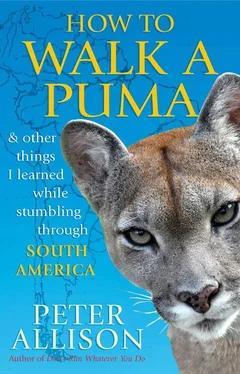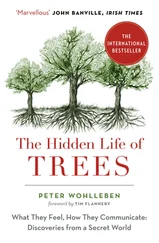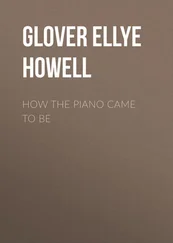There were other reasons for my regret, too. No longer at the mercy of his attacks, all I could think of was how vulnerable Roy was. I had no idea how much time Parque Machia would remain running before the drug growers’ road—stemming from the desire for cocaine in far parts of the world—shut it down. And I worried whether the supply of Roy Boys, never strong, could continue to trickle on. Strange as it would have seemed to me only a week before, on the day I left it wasn’t just raindrops wetting my cheeks.
Not the End of the World

After returning to the Gomezes’ house to recover from Roy’s attentions and rediscover the joys of Marguerite’s pisco sours, I found myself needing to recuperate from those beverages as well. This took me to not-too-distant Buenos Aires, where I had a wonderful reunion with my sister, Laurie, who was visiting Argentina from Australia. I also met Laurie’s friends Freddy and his wife, who invited us to dinner at their house in Buenos Aires, an occasion that inadvertently led me to the destination for my next journey.
‘Do you think Argentina is more like Switzerland or Ethiopia?’ Freddy asked at some stage of the evening.
I thought of the famous story of the Argentinian football players stranded after a plane crash who resorted to cannibalism in the bitter cold, I thought of condors soaring over the high Andes, I thought of fine Argentinian wine and the slopes where the grapes grew. Switzerland seemed the obvious answer, but even on our short acquaintance Freddy struck me as the sort of person who enjoyed trick questions, so I chose Ethiopia.
‘Exactly!’ was Freddy’s delighted reply. ‘Most of Argentina is desert—dry, horrible desert, barely worth farming. Only in the east and right at the south do you have mountains and snow. The south, Patagonia, that’s what a lot of people think Argentina is like. There it is cold, with high mountains, condors soaring, day-long sun … but that is only in Patagonia.’
By this stage the scars on my knee had faded enough that it looked like I’d been attacked by nothing more savage than acne, and I was keen to have a new adventure. Freddy’s description made me determined to visit Patagonia, a region of southern Argentina and Chile.
In travellers’ circles and in some literature, Patagonia is famous for its stark landscapes, bleak winds, peaks capped with year-round snow, and the largest sheet of ice outside the polar regions. Few animals survive there, but I thought I might be able to find pumas (something I now had mixed feelings about), penguins, seals and orcas. (Orca is the new name for killer whales, though I doubt the recent name change has altered their temperament.)
Patagonia also seemed to have a reputation as being one of the destinations of choice for those looking to have their soul shaken, or to find out if they have one. In the early 1800s Charles Darwin visited the island of Tierra del Fuego and reported seeing no structures, just the fires after which the island was named. He said the people were barely human; the most primitive he had ever seen. While I thought his comments about the people were needlessly unkind (and ignored how advanced they must have had to be to survive in such a place), I hoped that in Patagonia I would feel the wildness for which it is famous.
•
As soon as Laurie returned to Australia, I headed south to the Chilean town of Puerto Montt to take a flight to the furthermost reaches of Patagonia. I’d settled on Ushuaia on the island of Tierra del Fuego as my first destination. Proudly proclaimed by its residents as the world’s southernmost city, Ushuaia’s position in the south of Patagonia also made it a likely place to see condors close up.
My entrance into Ushuaia—flying in through a cleft in jagged, white-capped mountains—made me feel uncharacteristically optimistic. Nowhere I’d been in Africa looked remotely like this, and as an Australian I am easily impressed by mountains (the tallest peak in Australia requires a comparative stroll to reach its summit). The mountains around Ushuaia looked not just untrammelled, but untrammellable. Which is clearly not a real word, but was a very real feeling.
Walking through Ushuaia’s airport, I saw a tourist shop with a sign declaring it to be ‘The store at the end of the world at the airport at the end of the world’, something I thought a wee bit tacky. Then again, I long ago learnt the old adage ‘Never judge a place by its airport’.
By the time I got to San Martin, the main drag of Ushuaia, I was wondering if Charles Darwin would have been even harsher on the place if he’d visited today, since at least the locals he’d been so unkind about hadn’t tried to sell him anything. Hawkers squawked outside every bar and restaurant, trying to entice passers-by with dinner deals and happy-hour specials. I soon discovered that Ushuaia saw a lot of cruise passengers who stayed in town for only a few hours before heading on to Antarctica. The cruise-goers appeared in town soon after gangways were lowered, rolling down the street like a human tsunami dressed in yellow and red windproof parkas and tassled hats. There was a whiff of desperation in some of the stores, which flogged Argentinian soccer jerseys, mate (the local tea) and its associated tea-making paraphernalia, addictive local red wine, and miniature dolls dressed in the costumes of cultures either long gone or waning.
Two nights into my stay in Ushuaia, I was sitting in the common area of a backpackers’ hostel—the sort of accommodation I would use throughout my South American journey, even though I would often be the oldest person there—talking to a young German called Friederike. I’d been expressing my dissatisfaction with Ushuaia when Friederike said, ‘Maybe you’ve travelled too much. Perhaps you are too hard to impress now. I worry the same will happen to me.’
‘Maybe she’s right,’ I thought, and wondered if I’d been as wise as her at twenty-one (I suspect not). Maybe I was just too old for this near-hobo existence, I reflected yet again. But I had not been very successful in any field except guiding, and even that I had given up.
Despite such misgivings, I did have someone to look up who— thankfully—had no interest in hawking me a boat cruise, rental bicycle, or ‘end of the world’ snow dome. Freddy’s wife had a zoologist niece called Marcella who was in Ushuaia studying the breeding habits of Chilean swallows. Marcella took me on some of the many daytrips I made from Ushuaia in search of the overwhelming sense of isolation and wildness that the guidebooks described. She didn’t seem to mind me squelching along behind her as she checked the nests of Chilean swallows, which always seemed to be in a bog. Marcella was there to collect breeding data. This was as far south as any species of swallow went, so for them at least this really was the end of the world.
Walking in the bogs one day, I asked Marcella what the main source of employment for Ushuaians was. I’d learnt Ushuaia had a population of roughly twenty thousand people, not all of whom could possibly be in the trinket business, even if it felt that way.
‘Construction,’ Marcella replied, expertly plucking a newly hatched Chilean swallow from its nesting box. Unlike the adult plumage of muted grey underneath and dark blue above, this hatchling was pink and naked. Marcella blew on it to keep it warm, before dropping it into a small plastic bag, weighing it, marking a claw with nail polish, and returning it to its feathered sanctuary before repeating the process with one of its nestmates.
Читать дальше













